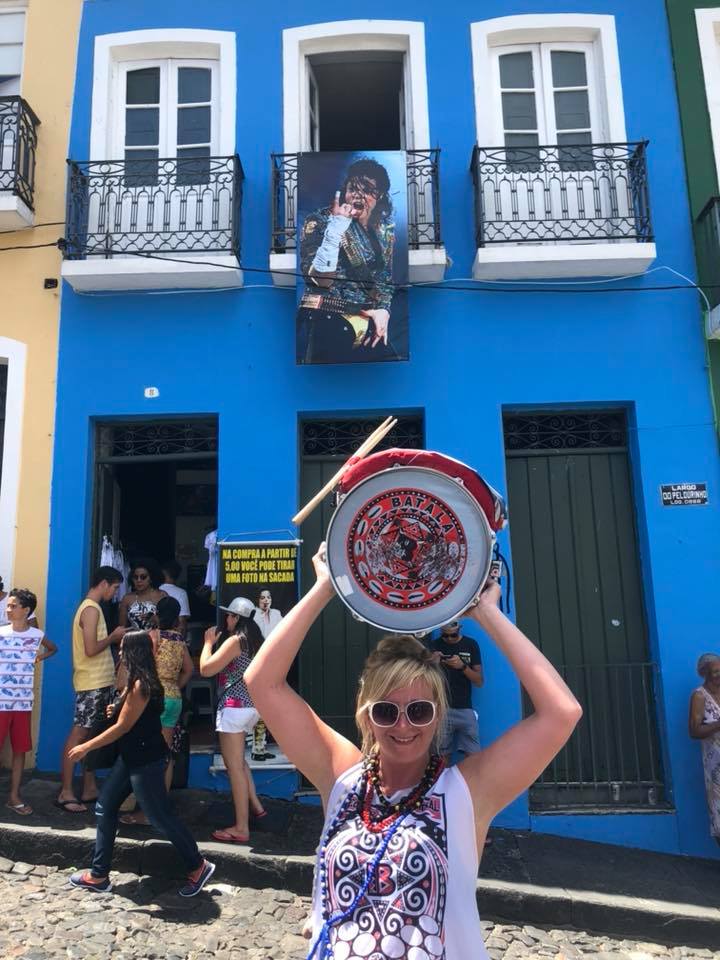Unforgettable Experiences and Practical Advice for Drummers and Samba Reggae Lovers
by Ilsa Parry
Find out what to expect, what to take, and what not to miss if visiting Salvador Carnival for the first time.
If you are a drummer, a Batala member, or simply just interested in Samba Reggae, to truly understand its heartbeat, a visit to Salvador Carnival is a must. However, making the financial and time commitment to travel halfway across the world and spend a few weeks in a country with a completely different language and cultural value set can be daunting.
If you’ve ever considered going there yourself, this blog post is designed to help you understand what to expect, what not to expect, and what makes it truly worth the visit.
Unmissable things to see and do
- Watch a performance by Olodum in the Pelourinho
- Participate in the Carnival at Campo Grande
- Experience Caipirinhas, Batidas and secret getaways
Practical advice
Unmissable things to see and do
Let’s start by talking about all the things that can make the historical city of Salvador the place to go for the trip of a lifetime. It’s a place of great significance for Batala members as the birthplace of our Bahian drumming rhythms, created by Afro-Brazilians during the 1970s as an extension of the Black Pride movement. Below are some suggestions to take you to the core of the culture, making the experience unforgettable.
1. Watch a performance by Olodum in the Pelourinho
Salvador was the first capital of colonial Brazil, one of the oldest cities in the Americas, and is the national centre of Afro-Brasilian culture. Salvador is also home to the first all-Black carnaval bloco “Ilê Aiyê“, one of many bands who continue to perform and influence the music style of the city during carnival season.
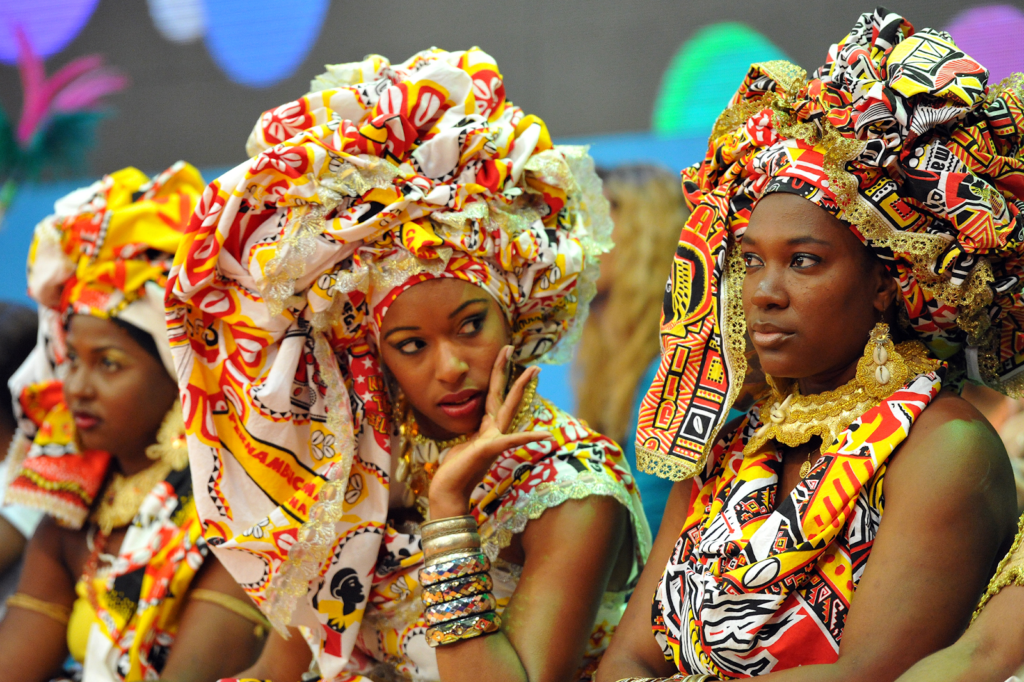

Whilst Filhos de Gandhy (Sons of Ghandi, est. 1949 by dockworkers) could be said to be the oldest Salvador percussion bloco, the best known by far has to be Olodum, who are widely credited with developing the “Samba Reggae” music style that Batala play, consisting of a mix of traditional Brazilian samba, merengue, salsa and reggae. Olodom gained worldwide notoriety for collaborating with Brazilian singers such as Daniella Mercury, and globally, with well-known household names such as Paul Simon (Obvious Child) and Michael Jackson (They Don’t Really Care About Us).

In Salvador, all of the bloco beats and lively dance performances happen on the street. During the carnival, each passage and every corner reveals new cultural and creative, percussion-based performances from bands and dancers throughout the day, but seeing Olodum perform in the flesh is something quite special.
In the build-up, you can wander around the Pelourinho, the historical centre of Salvador, made up of narrow, steep and cobbled streets with elaborate churches and pastel-painted buildings. You’ll hear the sound of other drumming bands, their resonance, increasing and decreasing as you move about, inviting you to come and watch. The shop-lined streets emit melodic calls from restauranteurs and shop owners in softly drawn-out Brazilian-Portugeuse to come and sample their local offerings.
You can experience the Olodum energy (Axé) twice weekly in the Pelourinho.
The show feels like a vibrant and colourful explosion of rich history, musical passion and shared celebration.
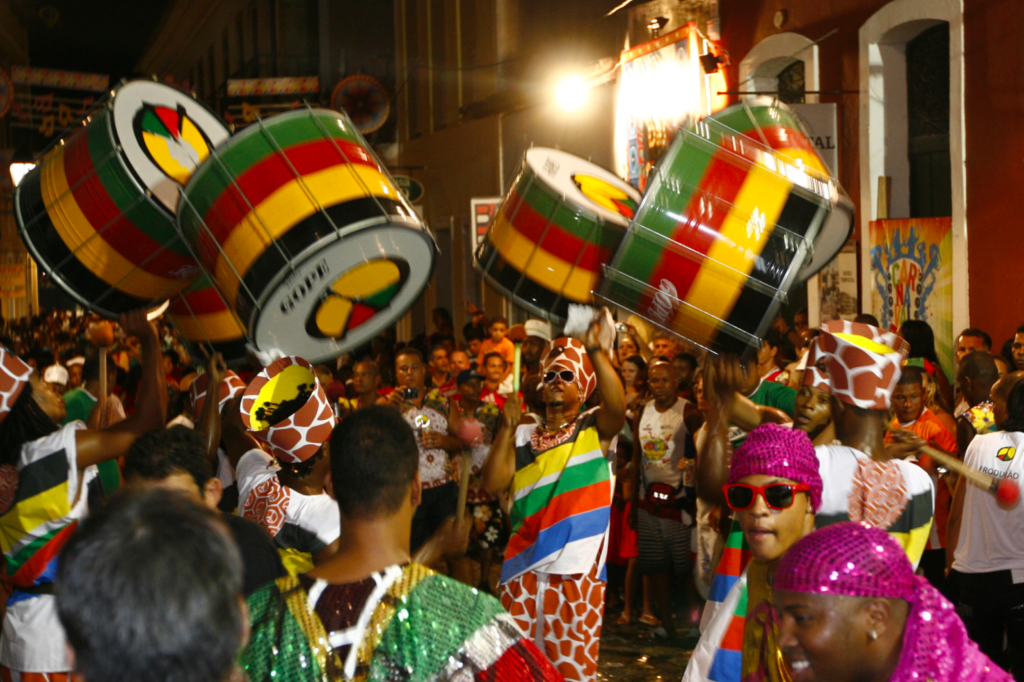
Pelourinho literally means “whipping post” in Portuguese and is indicative of the city’s dark past, as the home of the first slave market in the New World (1558-1835). African slaves were sent there under Portuguese colonial rule to work on the sugar plantations and were forced to abandon their Candomble religious beliefs and rituals and adopt Catholicism.
Candomblé means ‘dance in honour of the gods’, and music and dance are important parts of Candomblé ceremonies. Watching Olodum perform, can feel like a magical revival of a ghosted past, and an emotive, energetic and creative expression of human protest. Definitely a must-see!
2. Participate in the Carnival at Campo Grande
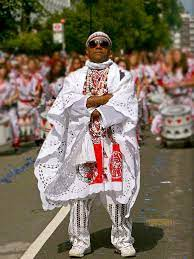
Batala’s founder, Giba Gonçalves has created nearly 50 sister bands around the world. Every year he encourages members to visit his home city and take part in carnival. Since 1997 he has been on a mission to bring the music and culture of Bahia from the streets of Salvador to the streets of the world.
“It’s essential for all Batala players to go to Brazil to see how it works”.
Giba Gonçalves
Giba lives a 5-minute walk from the Pelourinho and works as musical director of a number of non-Batala bands, including the closely connected “Cortejo Afro” who work with Batala members during carnival, to teach them their own rhythms in order for us to participate as drummers in their bloco at “O Carnaval do Campo Grande”. The biggest carnival in the world.
Participating in this carnival is quite an honour, yet it can be a heady mix of euphoria and exhaustion at a heightened scale for even the most experienced players. In our case, several days of rehearsal with Mestre Gordo from Cortejo Afro, prepared us for understanding what to play.
We were also given intrinsically beautiful carnival costumes, decorated with meaningful symbols and references to the Candomble Orixas, designed by Alberto Pitta, who is a well-known Brazilian textile artist, with time served as creative director for all four of the carnival blocos previously mentioned in this post.


The second participation at Campo Grande in particular did not disappoint. The build-up on the streets before the procession begins to move is a sensual feast, with carnival dancers and drummers. wearing elaborate and traditional costumes wandering up and down the lines in anticipation. Street vendors are everywhere producing aromas of authentic feijoada and freshly squeezed limes to help the participants’ energy levels, whilst music rises from the speakers of the trios, warming up for the main event.
Suddenly, it’s time to go, drums are strapped on and beaters are at the ready, to begin with a bang. The trio singers blast the intro, the mestres wave their hands, and we are off! Six hours of drumming and marching along the coastline, through the night, protected by a cortage of rope handlers, surrounding the whole bloco and keeping out the party go-ers.
The music we played was fairly simple with lots of repetition in order to give the drummers longevity. Due to the flowing nature of the procession, with one trio and bloco behind the other, to each section of the crowd, we were still bringing a new sound. The main rhythms were interjected with occasional breaks led by the repinique, at landmark points in our long performance.
Smart players organised drum-sharing groups. This consisted of between 2-4 individuals (depending on drum size) committing to taking turns to play the drum. This allowed people to have regular breaks, drink a caipirinha, and soak up the vibrant atmosphere.
If it’s not too crowded and safe to do so, in parts you can leave the bloco and go watch the other bands. Vast numbers of floating stages featuring some of the best musicians in the world, force your feet to dance and evoke a permanent grin.
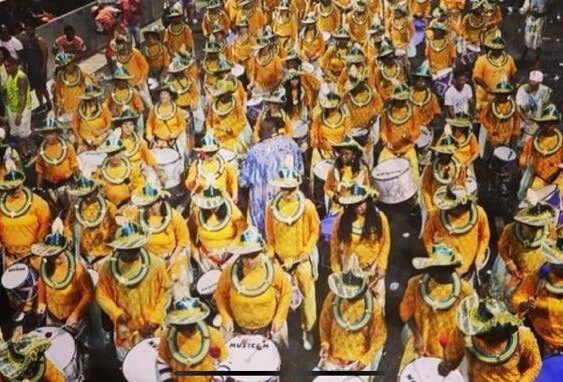
It’s a fairytale moment to see millions of people dancing and singing in unison everywhere you look. Possibly the most colourful celebration you will ever see, a very powerful experience.
3. Experience Caipirinhas, batidas, and secret getaways
If you are in Salvador for carnival, you will experience a state of permanent stimulation. Whether you’re looking to ramp it up or wind it down, there are a number of very different local drinks to try, all based on the Bahian traditional sugar cane spirit known as Cachaça (pronounced kah-sha-sah).

If you are participating in the carnival, you will likely be given some “Capeta Batida” (translating as devil’s shake) poured into a small cup from a large bottle by a carnival helper. This drink tastes like lightly spiked chocolate milk with cinnamon. It usually contains guarana powder, which comes from a berry grown in Brazil and Venezuela and is sold in health food stores as an energy supplement.
The Cachaça smell is disguised by the cinnamon, and probably why it’s referred to as the devil’s drink, because it spikes you unknowingly, so only take a small cup!
There are other Cachaça “shakes” or batidas that are readily available, two of my personal favourites are “Batida de coco” (coconut shake), and “Batida de gingembre” (ginger shake), it’s quite funny to try and pronounce for the first time, give it a try… “ba-te-daah-zgee-zgheen-zghem-bree”.
The first, when poured over a glass of ice, is like sipping on liquid coconut cream. Smooth, creamy and delicious! The second one has quite a spiky kick to it and it’s Giba’s favourite. He and his close friends can be found indulging in a glass with lunch cooked by his sisters in the Batala house courtyard during carnival. It makes for a great start to a lively afternoon. A little-known secret for first-time go-ers is that you can buy both by the bottle for about £4, made whilst you wait at the restaurant opposite his house.
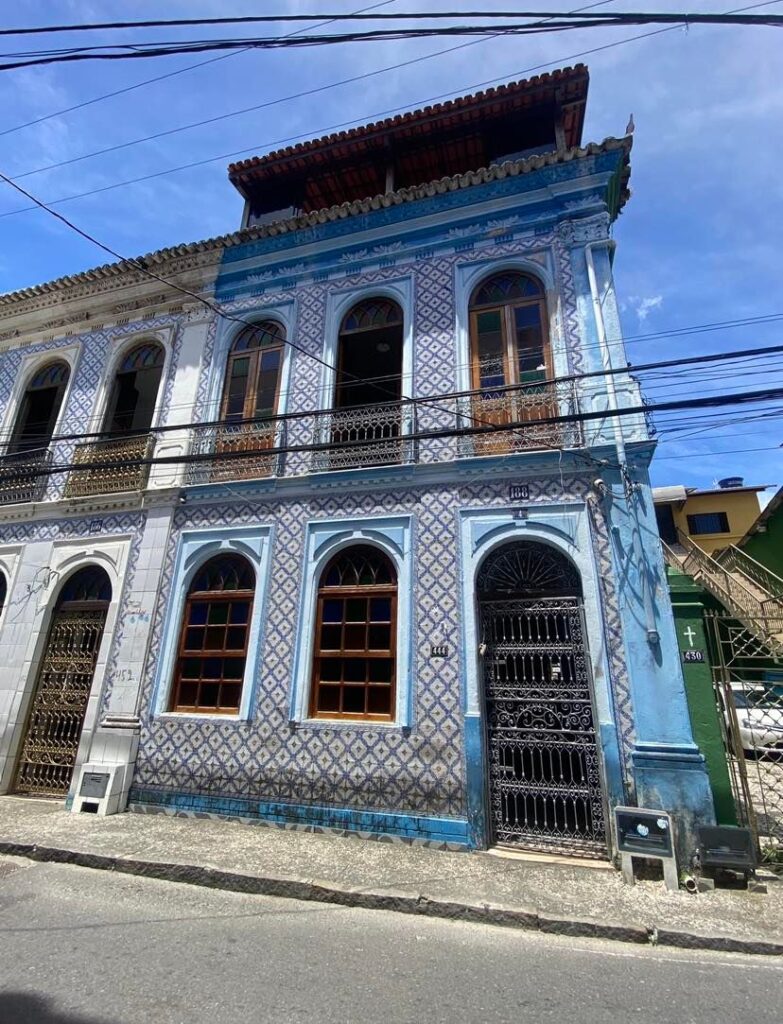
Cachaça is used for more than batida shakes. The most famous drinks in Brazil are arguably “Caipirinha” (meaning little countryside drink) and “Caipiroska” (little Russian countryside drink). The difference between the two is that the first is Brazilian cachaça based and the second is made with vodka.
Both are readily available at nearly all bars and restaurants and are made up of pummeled fruits such as strawberries, passion fruit, raspberries, or kiwis ground up with Brazilian cane sugar, mixed with straight cachaça or vodka in a tall glass with crushed ice. The most famous of them all though is the traditional lime-based Caipirinha, refreshingly simple and thoroughly reviving, the perfect accompaniment to parties and relaxing beach trips alike.
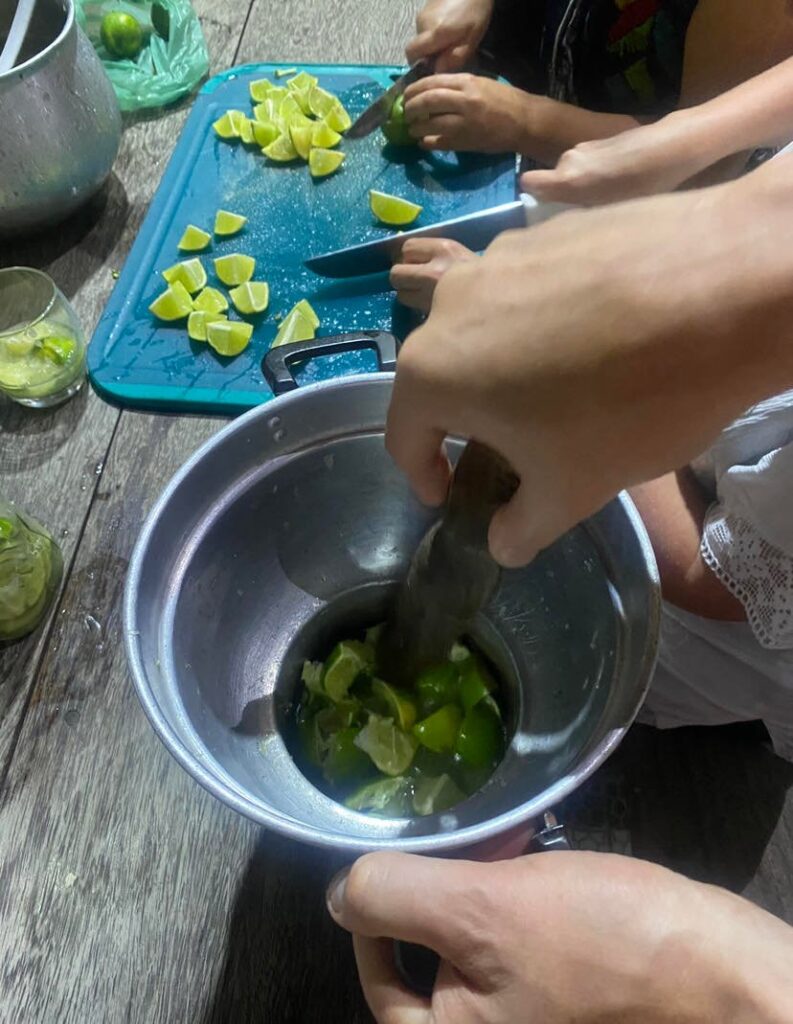

We found a few places to sample the best of the Caipirinhas during mini escapes from the hustle of Salvador city, and the high energy of the Pelourinho.
The first is about a 40-minute Uber ride away to the east coast of Salvador “Praia de Flamengo” (easily confused with “Praia do Flamingo” which will take you about four hours south and cost ten times more).
A trip east to Flamengo will cost about £10 and will take you to an idyllic beachside setting with free sunbeds table service, supported by large “hut style” bars and restaurants serving traditional Bahian food such as “Moqueca” and tableside hammocks. It’s the perfect place to take a day off and chill with friends, but be aware that the tide is strong, the sea bed is rocky, and swimming is not safe or advised.
If you are looking to explore a little further, then I would highly recommend a boat trip to Itaparica, a large island southwest of Salvador.
We found one locally for about £40 which was a full ten hours out. We were picked up from outside our accommodation in an air-conditioned bus and taken to the port of Salvador, loaded on a boat with ample space, we snoozed and relaxed with soft drinks until arriving at our first port of call which was a beautiful smaller island north of Itaparica “Praia de Nossa Senhora de Guadalupe”. A truly idyllic paradise with a large strip of native forest and calm, warm crystalline waters, protected by its central position in the Bay of All Saints.
The tour guide provides an area where parasols and beach mats are free, but be prepared to pay over the odds for drinks and snacks. We spent about two hours here before moving on to Itaprica.
At Itaparica, we enjoyed the most magnificent feast of food you could imagine at Restaurante Manguezal (cost an extra £12 per person), a huge buffet consisting of three full tables of authentic, locally sourced foods of every kind. We enjoyed another short dip in the sea here before heading back to Salvador, entertained by a local small drumming band on the boat and enjoying Caipirinhas as a group for £5 each.
At the end of our carnival experience, to unwind, we decided to have a mini-break. We first enjoyed a party at a friend’s beach house (with pool) 90 minutes north of Salvador in Garajuba, (which backed onto more amazing beaches), then headed further north to Imbassai for three days where we stayed in a calming and quiet “jungle like” retreat and chilled by the poolside. It was the perfect way to end our trip and refresh in advance of the long journey home.
If you are looking to extend your stay and travel further afield, through Bahia and beyond, my previous Salvador trip took me four hours south by bus to the beaches of Itacare, which was literally the most mind-blowing beach landscape I have ever seen, and also through to central Bahia to Chapada Diamantina national park for a four-day hike through the most incredible rocky landscape.
If, unlike us, you want to extend the party and continue to do more of the same, Rio carnival, I am told, also a once-in-a-lifetime experience and a very different vibe to Salvador.
Practical advice
My own experience told me that advance planning for this trip is really valuable. Some things that we take for granted here are inaccessible at times in Salvador, especially during carnival!
1. Order cash in advance
Cash is an obvious essential, but getting hold of Brazilian Reais in the UK can be more difficult than you might expect. We had to pre-order the cash from a London firm a few weeks in advance to be sent to us by post, as none of the local bureaus de change had any stock.
We took the equivalent of around £500 which is just over 3200R. For general spending money (covering things like meals out, drinks, souvenirs and entertainment) this was about ⅔ of what we needed for two people on a three-week trip.
I would say that an individual who wants to do something fun each day should expect to spend around £150 per week.
Most things in Salvador are a LOT cheaper to access than in the UK, but travellers should be aware that prices that are not clearly listed can change by the minute, and are sometimes made up by staff depending on how they feel on the day!
We ran out of cash two or three times on the trip. One day in particular I walked around the city for nearly three hours trying to find an open bank or working cash point, only to be disappointed time and again. This left me in a bit of a pickle, whilst most vendors now do take cards, there are many that still don’t.
Having said all of this, it’s important to mention that taking too much cash should be carefully considered and handled too. Parts of Salvador during carnival can be hotspots for theft, though this has reduced drastically recently with a strong tourist police presence.
2. Plan your essentials
Mobile data.
- Get a data plan or sim card before you go. Wi-Fi is hard to come by even at hostels and hotels and when you do find it, it’s less than reliable. Simple tasks like finding where to go, translating a sentence or ordering a taxi can become near impossible if you don’t have access to phone data.
- To ensure you can get about and communicate your needs, plan to either buy a Brazilian sim card online before you go or consult with your own or another data provider for the best block data deals in advance.
Medical
- Pharmacies are also less prevalent in Salvador than you might find in European countries, so ensure you have taken an ample supply of any prescription medicines with you when you go. I would also advise rehydration tablets containing electrolytes and factor 50 sun cream.
- The climate, especially in February during carnival season, can cause the body to dehydrate really quickly, even without alcohol! It can be very humid and you will sweat a LOT! Plus the streets in Salvador have very steep climbs and drops back and to from the Pelourinho which increases exertion and exacerbates fluid loss. Buy a large bottle of water daily to keep in your room, you should NEVER drink tap water in Salvador, and, if you’re British, or prefer a hot drink, take tea bags! Tea of any kind is impossible to find…
- Don’t think “I’ll be ok with factor 30”. Just don’t. From 6 am in the morning, the sun is STRONG through until at least 2 pm in the afternoon. It only takes 5 minutes of exposure in direct sunlight to cause the skin to burn. A friend of ours fell asleep in the shade at the beach for 1 hour wearing factor 30 at the beach, during this time the sun position moved and his feet were exposed. He ended up in hospital with 2nd and 3rd-degree burns, was in pain for most of the trip and couldn’t play carnival.
3. Bring your home comforts
Your usual comforts and regular go-to’s will be harder to source in Salvador. This includes food, toiletries, and even appropriate bedding… During carnival, shops seem to close early and randomly when you least expect it. Waiting times for food at restaurants can also be extraordinarily long!
I was surprised by how difficult it could be to satiate my hunger daily! Lots of walking, extreme heat, and exertion (if you are there to drum or dance) mean that you are burning a lot more calories than usual and you should keep some favourite snacks to hand to keep energy levels topped up.
One day during carnival, we waited nearly 3 hours for a simple lunch of chicken, rice, and vegetables, in the evening, a “main meal” at a bar can be surprisingly underwhelming, consisting of just a meat skewer and a handful of veg. If you are travelling with a group of friends and have the opportunity to buy into shared cooking as an alternative to eating out, I would strongly advise you to take it…
Things like shampoos, laundry detergent, and hygiene essentials are different from what you might be used to, so if you have hair or skin sensitivities, plan to take your trusted items with you in advance. The bathing water supply can also be temperamental depending on where you stay, due to how the water is pumped and contained. I would advise storing a small amount of water and taking baby wipes for hygiene use (but don’t flush them).
If you are staying in a hostel or similar, don’t expect a comfortable bed. Air conditioning is not given so a small fan might also be helpful to stay cool at night. A travel pillow is a good idea and can be used for long day trips as well as during the night.
My best advice would be to take a thin cotton scarf that can be dampened and placed over your body whilst sleeping to help you stay cool. If you are flush for money and want to ensure your comfort, many take an extra suitcase with a blow-up bed and pump.
If you have reached the end of this post, you should now be fully briefed on where to go, what to seek out, and what preparation to do in advance. I would encourage EVERYONE with an interest in Samba Reggae to experience Salvador carnival at least once.
If you have the time and the cash, make the energy and go, it changes you!
Ilsa Parry
